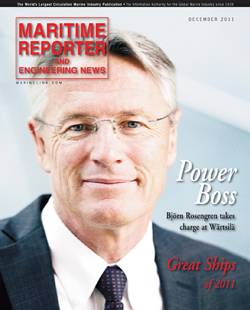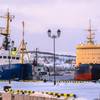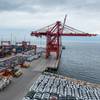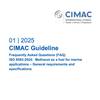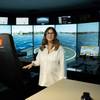Björn Rosengren was appointed President and CEO at Wärtsilä Corporation, as from September 1 this year. In a recent interview he told Maritime Reporter his views on the current business environment, the markets and about tasks ahead.
Henrik Segercrantz reports.
Wärtsilä, a leading global provider of power solutions for ships and power plants, is a global market leader in some of its segments. On the maritime side, the group has over the years expanded from its core products, that of producing medium- and low-speed engines, into a provider of a wide portfolio of related products, such as propellers, waterjet propulsion, shaft seals, gears, automation, ship design, scrubbers and ballast water treatment systems, to mention some. This has taken place through the acquisition of key companies in these sectors, and through own development work. Production is increasingly built up in Asia. The lifecycle of the products is emphasized by the group, and services have become a major part of its business. Research and Development are key elements of operations, providing solutions to meet the continuous need for increased efficiency and for decreased environmental footprint, and to develop new products. The growing LNG segment, the use of liquefied natural gas as engine fuel, is gaining much focus, and much work is also directed at bio-fuels and on fuel-cell power.
Maritime Reporter met with Mr. Rosengren a few weeks after he had presented the third quarter results of his new employer, the Wärtsilä Group, at the headquarters in Helsinki, Finland. "Summarizing the third quarter results I think they were quite good considering how the surrounding world looks like today, with all the question marks that are out there. The strong cards were that we still see good growth in order intake, which is important, and we also see good profitability, in relation to our sales. The basis feels right," Mr. Rosengren reflects.
The year to date for Wärtsilä's Ship Power and Power Plants businesses have shown good order intake, relatively speaking, already matching that of 2009, and expected to beat the figures of 2010, some EUR4b. The sales figures are down year on year by four percent on group level, but profitability remains a high eleven percent. Particularly positive development has been seen in the Power Plants segment, a more even development in Services, but not so in Ship Power, which Rosengren also points out. "There are sectors with bigger challenges and one of them is of course the maritime sector, not the least because many shipowners today have difficulties with their profitability. Overcapacity and low freight rates result in the need to save in costs as much as possible, in investments and in costs in general. This is seen partly in our Services sector but also in the newbuilding orderbooks at the shipyards."
At the Q3 presentation Mr. Rosengren had shown a graph of the development of global contracting activity within the maritime sector, reminding the analysts in the audience of the gloomy prevailing conditions, with the ship contracting volumes of 2010 and 2011, so far, only a third or a fourth of the boom levels a few years back. For the third quarter, the curves were pointing further down, particularly in deadweight tons if not in the number of vessels. "There are segments which perform better. One has been offshore and another is the LNG sector," Rosengren points out. Both of these areas are strong for Wärtsilä, which has offset the effects of the current tough times "so far relatively well," as Rosengren puts it.
For the first time Wärtsilä also reported numbers from their joint ventures in engine manufacturing, and the reason for this was clear. "The order intake from the joint venture side was this quarter roughly the same size as that of our Ship Power operations. This is a result of our strategy which has now started to show results," Rosengren notes. Wärtsilä has a 50/50-owned joint venture for the manufacturing of dual-fuel engines for LNG carriers, with Hyundai Heavy Industries in South Korea. "44 of these ships were order during the third quarter, which is fantastic, and in this quarter we have already received engine orders for 16 of these vessels. Our market share in these engines is nearly 90 percent, so I believe we will receive some more engine orders for these vessels in the coming quarters." Wärtsilä also operates a joint venture in Shanghai, Wärtsilä Qiyao Diesel Company, which focuses on auxiliary engine manufacturing. The total order intake from these joint ventures in the third quarter was EUR182m, nearly as much as that of Ship Power.
The company's activities in China also include production of low-speed engines, through a 27% share in a joint venture with China Shipbuilding Industry Corporation (50%) and Mitsubishi (23%). Also thrusters and propellers are produced in China. The company is currently building up a new joint venture in Nantong for the assembly of the Wärtsilä 32 and Wärtsilä 26 types of medium-speed marine engines, for the Chinese market. "This is very important for us. We talk about our 32 engine, which is our crown jewel. We set up this joint venture to strengthen our market shares in China," Rosengren points out. The partners of Wärtsilä are the local community Nantong, the State, and a private investor. Wärtsilä provides the engine know-how and is also to build an industrial park around the plant, to provide the possibility for key suppliers to start manufacturing locally. "We will work much on setting up local manufacturing of engine components in order to receive a competitive cost structure."
The markets in China and in Asia in general are very important for Wärtsilä. Rosengren says their position is unique, for a Western company, in that 40 percent of business comes from Asia. "On the Power Plant side we see a number of key countries and markets globally, but thinking at Ship Power, we talk above all about South Korea, China and somewhat Japan," he says. He notes that Japan has it much more difficult now due to their high currency exchange rate which results in high manufacturing costs. But still, the engines for the local Japanese market are manufactured in Japan. "The big markets for us are Korea and China and this is how it will be also when looking forward."
"Another interesting market is Brazil, which we believe in much. In order to be able to sell to the big companies in Brazil, such as Petrobras and VALE, you have to have more than 60 percent manufactured locally," Rosengren points out. In Brazil, Wärtsilä has a licence agreement with Nuclebras Equipamentos Pesados S.A., NUCLEP, which grants NUCLEP the right to manufacture Wärtsilä's electronically-controlled common-rail two-stroke marine diesel engines. Joint production is now being planned, through a letter of intent signed in February this year.
Wärtsilä's Power Plants segment is very active in marketing its power plants for the US market, also for providing back-up power. On the Ship Power side, Wärtsilä recently received the order for the dual-fuel engines for the first two U.S. flagged offshore supply vessel to run on environmentally beneficial LNG, the newbuildings for Harvey Gulf International Marine. This order includes the LNG fuel storage and handling components and also the electrical and automation package and the complete electric propulsion system. Wärtsilä also recently signed a cooperation agreement with Shell Oil Company, producing oil and gas also in the Gulf of Mexico, aiming at promoting and accelerating the use of liquefied natural gas as a marine fuel. The cooperation first focuses on supplies from the US Gulf Coast, and then later to expand to cover a broader geographical range. Supplies of low cost, low emissions LNG fuel will be made available to Wärtsilä natural gas powered vessel operators and to other customers, by Shell. "It is in our strategy to further develop the gas side regarding gas engines and the usage of gas as fuel," Rosengren comments this agreement. "An important part of making gas an alternative to heavy fuel oil is a good distribution network."
In tough world market conditions the focus on increased productivity becomes even more important, and that of adjusting production capacity to demand. In 2009 Wärtsilä initiated restructuring programs aiming at annual savings of approximately EUR130m. The restructuring will be finalized this year and is almost completed. It included a staff cut of some 1,800 people. "Our organisation is now adapted to the current orderbook size. We have no plans in this situation to start a new such program. If the world crashes we have to look at that separately, but as things look like now, the organisation feels right," Rosengren says calmly. He though adds: "On the offshore vessel side, competition is increasing and also the price pressure, which is worrying."
Reflecting on the current markets and on Wärtsilä's strengths, Rosengren points out the different segments of Wärtsilä, providing a balance. "We have Power Plants, which is doing well. We have Services, which does not grow much right now but has stayed on a quite constant level. Then we have Ship Power, which is growing compared to last year, but is still on a very low level compared to what one was used to before 2008. What is important now is to keep our market shares in the segments which move. This is important."
He also sees new opportunities within the gas sector, for LNG carriers but also for other types of vessels. "With our dual-fuel engines we feel we have a good position here. We do not know exactly how long time it will take for this market to take effect, but it is completely obvious that the environmental regulations on SOx and NOx will affect this market. With the gas engines we have we can fulfil the environmental requirements of the SECA and ECA restricted areas. We can help our clients to fulfil existing and coming regulations, both on the ballast water side and what comes to emissions. This is an important area for us, and an area in which we will invest much and where we see much potential." How big can this sector become, for you? "We do not have exact data on that yet. We know that on the ballast water side, between 60,000 and 70,000 vessels have to be converted, according to a North-American consulting company. If we look at the cost which has to be invested on each of these vessels, it is between half a million and four million US dollars, we talk about very much money. On the emission side the numbers are even bigger, but over a longer time frame. The ballast water side is to come first." Wärtsilä has indeed the right structure for this mega-size conversion process ahead, to provide the new equipment needed onboard the world fleet. The group has service centres at 160 locations and more than 7,000 service technicians placed globally.
Before his appointment as President and CEO of Wärtsilä, Björn Rosengren lived in Shanghai for one year as Senior Executive Vice President for the big Swedish industrial company Atlas Copco AB. He headed the Construction and Mining Technique operations of the group, which has some 68 production sites in 20 countries and employs some 33,000 people, and as of year 2010 with China as its largest single market. One can understand that Mr. Rosengren shares the views of the importance of Asia with the Board of Wärtsilä Corporation. At 52 years of age, he has headed a number of companies during his career. He graduated as a M.Sc. in Technology at Chalmers in Gothenburg, Sweden, back in 1985. "I like China very much. It is easy to live there nowadays," he tells Maritime Reporter. "If you want to be such a big company as Wärtsilä, calling itself a world leading company, it is very important also to have a leading position in China. Otherwise I think things will become difficult in the future. One has to be present and one has to be able to adapt the cost structure of your products for the market. If one does not succeed in this, it will become very difficult going forward."
(As published in the December 2011 edition of Maritime Reporter & Engineering News - www.marinelink.com)



